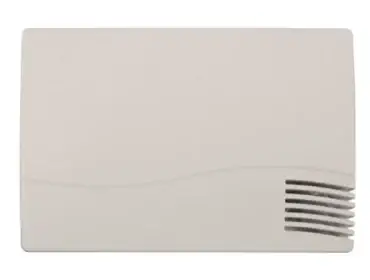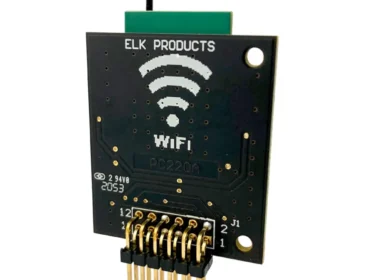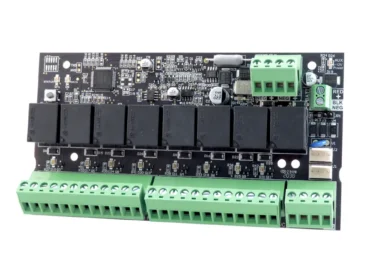Key Features:
- Remote Receiver Adapter: Allows an ELK wireless receiver/transceiver (AERF3 or AERF9) to be connected via the Alarm Engine’s 4-wire data bus rather than directly on the main board. This means you can install the receiver in a location that optimizes RF performance (high up, centrally located, or away from sources of interference) while still communicating with the main panel.
- Supports One-Way or Two-Way Receivers: Equipped with a connector that accepts either the ELK-AERF3 (319.5 MHz one-way) or ELK-AERF9 (902–928 MHz two-way) wireless modules. The adapter automatically accommodates whichever type is inserted, so you can use it to expand one-way sensor coverage, two-way sensor coverage, or both (by using multiple adapters for different receiver types as needed).
- Multiple Units for Large Coverage: You can use up to 4 AEXRFA adapters on the E27 bus simultaneously. This opens the door to installing multiple wireless receivers – for example, one on each floor of a multi-story building or in separate wings of a facility – greatly extending the range and reliability of the system’s wireless network. All receivers on the bus work in tandem to feed sensor signals to the panel, eliminating dead zones.
- Integrated Antenna and Housing: The kit includes an offset antenna for each frequency band (one antenna optimized for 319.5 MHz and one for 902 MHz). These antennas attach to the adapter to ensure strong signal for the installed receiver. The AEXRFA comes with a dedicated plastic enclosure that neatly holds the adapter board and receiver, with mounting flanges for easy wall or ceiling installation. The enclosure helps protect the electronics and provides a professional-looking finish.
- Maintains Full Functionality: Using the AEXRFA does not limit the receiver’s capabilities – all wireless sensors can be learned/enrolled and will report to the panel as if the receiver were on-board. Supervision signals, tamper signals, and status updates are all transmitted over the data bus. LED indicators on the attached receiver (AERF3/AERF9) remain visible through the adapter, so you still get diagnostic feedback at the remote location.
- Simple Setup: Connecting an AEXRFA is as straightforward as wiring a keypad: just connect 4 wires (12V+, 12V-, Data A, Data B) from the module to the Alarm Engine’s bus terminals. Each adapter has a device address set by jumpers or DIP switches (refer to instructions) so the panel can supervise it. Power for the receiver is delivered through the adapter from the bus. It’s a plug-and-play solution to enhance your wireless coverage without special tools or programming beyond enrollment of the new sensors.
Technical Specifications:
- Function: Data bus adapter for one wireless receiver. Bridges an ELK-AERF series receiver to the E27 Alarm Engine via RS-485 bus, enabling remote or multiple receiver installations.
- Compatible Receivers: ELK-AERF3 (319.5 MHz one-way) and ELK-AERF9 (902–928 MHz two-way) are both supported. The adapter has mounting and electrical connections for these modules. Note: Receiver modules are not included with AEXRFA itself (they are purchased separately or as part of kit versions like AEXRFA3 or AEXRFA9).
- Power Requirements: 12 V DC (supplied via the data bus from the panel or auxiliary power source). Current Draw: 27 mA (adapter board only); approximately 79 mA with an AERF3 receiver installed; ~112 mA with an AERF9 transceiver installed. Ensure the panel’s auxiliary power capacity accounts for all attached bus devices.
- Data Bus Usage: Standard 4-wire Alarm Engine bus. Each AEXRFA occupies one bus address. Up to 4 adapters can be used per system (in practice, you could mix and match AERF3 and AERF9 on these adapters as needed). They can co-exist with other bus devices like keypads, input/output expanders, etc.
- Physical Dimensions: Board size ~3.5″ x 3.94″ x 0.56″; with enclosure ~4.25″ x 6.36″ x 2.13″. The off-white plastic enclosure is designed for surface mounting and includes a removable lid for access. It’s discreet and can be placed in attic spaces, closets, or near the area of coverage needed.
- Included Components: Alarm Engine RF bus adapter board (ELK-AEXRFA), one offset antenna for 319.5 MHz (for use with AERF3), one offset antenna for 902–928 MHz (for use with AERF9), plastic clam-shell housing, mounting screws and hardware, and installation instructions. If you purchase a kit version (e.g., ELK-AEXRFA3 or AEXRFA9), it will also include the corresponding receiver module pre-packaged.
- Usage Example: To extend wireless coverage, you might mount an AEXRFA with an AERF3 receiver in a detached garage to pick up signals from wireless sensors there, while another AEXRFA with an AERF9 is in the main house’s second floor to ensure two-way devices (like wireless smoke alarms) communicate reliably. All these feed back to the one Alarm Engine panel over the data bus. The flexibility of the AEXRFA is key to creating a robust, wide-ranging wireless alarm system.






There are no reviews yet.